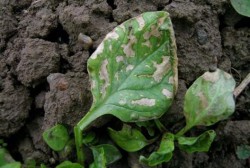Spinich Leafminer- Identification and Management

The adult fly appears in early to mid- May after overwintering in the soil as pupae. It is a about 5 mm long and are gray in color. The adults can be seen flying near the ground between the plants. The females deposit eggs singly or in rows of two to five side by side on the underside of the leaves. In as little as three days but more commonly in four to six days the tiny legless, white to yellowish maggots hatch from the eggs and work their way into the leaf tissue. The maggots feed between the upper and lower leaf surfaces of the host plants mining out the tissue in between. It is not unusual for several larvae to be in the same leaf. As the maggot grows and continues to feed, the mines, which are at first thread-like, become blotch-like and are easily seen on the infected leaves. The larvae are full-grown in 7 to 16 days when they drop to the ground and burrow a few inches into the soil to pupate. Two to four weeks later the adult flies emerge and will soon lay eggs for another generation. In New York you can expect three to four generations each year.
Management- a preventive spray schedule beginning when the spinach is two true leaves and repeated every 7 days. Remove wild hosts like lambsquarter, nightshades, chickweed, and plantain. Deep plowing in the spring can reduce the overwintering population by burying existing pupae. In smaller stands, infected leaves can be picked before the maggots drop to the ground. Removing and destroying these infected leaves can lessen the leafminer pressure
-Ray Range

Upcoming Events
Ag Labor Road Show IX
December 1, 2025 : Save the Date! - Ag Labor Roadshow Webinar 1
In addition to the in-person Ag Labor Roadshow program in our region on December 9, two webinars are scheduled for December 1 and December 22. Each webinar will focus on different program content that is different from the in-person sessions. These webinars are an added benefit to program registration.
December 9, 2025 : Save the Date - Ag Labor Road Show In-Person Event (Greenwich, NY)
Greenwich, NY
The Roadshow delivers essential updates on labor law, regulations, and workforce best practices—tailored for farm owners, managers, and ag service providers. Sessions also focus on practical strategies to boost communication, strengthen retention, and build a positive workplace culture.
The in-person session for Eastern NY is December 9 - Elks Lodge, Greenwich, NY - full day in person session
Additional in-person sessions are:
December 10 - Hilton Garden Inn, Watertown, NY, December 17 - Cornell AgriTech, Geneva, NY, December 18 - Genesee Community College, Batavia, NY
December 22, 2025 : Save the Date! - Ag Labor Roadshow Webinar 2
In addition to the in-person Ag Labor Roadshow program in our region on December 9, two webinars are scheduled for December 1 and December 22. Each webinar will focus on different program content that is different from the in-person sessions. These webinars are an added benefit to program registration.
How to Obtain a Pesticide Applicator License
December 17, 2025
Thinking about becoming a certified pesticide applicator in New York, but aren't sure where to start? Join DEC representative Kenneth Klubek for a discussion on who needs to become a certified pesticide applicator, certification types, examination procedures, and recertification. Participants will have ample opportunity to ask questions during the program.
2026 Winter Cut Flower Webinar Series
January 6, 2026 : Session 1: Cut Flower Cost Calculator Updates and Woody Cuts
Session 1: Cut Flower Cost Calculator Updates and Woody Cuts
January 13, 2026 : Session 2: Perennials and Industry Trends
Session 2: Perennials and Industry Trends
January 20, 2026 : Session 3: Anaerobic Soil Disinfestation and Biochar
Session 3: Anaerobic Soil Disinfestation and Biochar
January 27, 2026 : Session 4: Beneficial Insects and Propagation Techniques
Session 4: Beneficial Insects and Propagation Techniques
February 3, 2026 : Session 5: Fungal and Insect Pests and Market Trends
Session 5: Fungal and Insect Pests and Market Trends












































